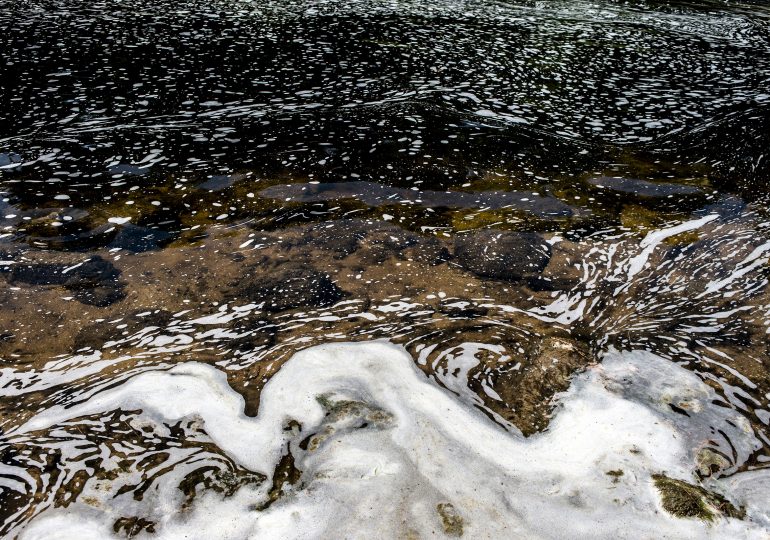The U.S. military has been protecting the home front for nearly 250 years—and doing a bang-up job of it. In recent decades, however, the military has also been polluting the home front, most notably with a toxic chemical never heard of in the era of muskets and drums: PFAS. That’s becoming a major problem—one that is now teeing up a major clash between environmental groups and the Environmental Protection Agency (EPA) on the one hand and the Department of Defense (DoD) on the other.
[time-brightcove not-tgx=”true”]
Short for per- and polyfluoroalkyl substances, PFAS is an umbrella term for more than 12,000 substances colloquially known as “forever chemicals,” because that’s pretty much how long they linger in the environment and the body. PFAS have been linked to increased risk of kidney, testicular, and other cancers; changes in metabolism; higher cholesterol; low birthweight; pregnancy-related hypertension; damage to the immune system, and more. Virtually no one is safe: according to the U.S. Centers for Disease Control and Prevention (CDC), 99% of Americans have detectable levels of PFAS in their blood.
The ubiquity of PFAS is due to the fact that the chemicals are used in thousands of commercial products, from non-stick cookware to menstrual products, toilet paper, and fire-fighting foam. When it comes to the military, it’s the foam that’s causing the biggest headache, since fuel fires, especially those related to aircraft, are common on bases and other installations.
Now we’re getting a clearer idea of how serious the military’s PFAS problem is. According to a Sept. 3 memo from Assistant Secretary of Defense Brendan M. Owens, about 80%—or 578 of 710—military bases across the country are known to have or suspected of having elevated levels of PFAS in their soil and water supplies. That comes as very bad news, because toxins that are on the military sites don’t stay on the military sites. Instead, they seep into the groundwater and private wells in the surrounding communities, raising the question of who is responsible for remedying the problem and how fast that work can be done.
The DoD acknowledges its role in creating the PFAS mess and, nominally at least, insists that it is taking steps to clean it up both on military bases and in the affected communities off-base. “PFAS remains a complex national issue and a whole-of-government approach is underway to address it,” said Owens in an email to TIME. “Implementing solutions that reduce impacts of PFAS from past DoD activities is one of my key focus areas. DoD has moved out and implemented remedial actions at dozens of sites and we will continue our investigations and implement solutions at the other locations where past DoD activities require action.”
But dozens of sites is a whole lot fewer than hundreds of sites and the statement is conspicuous for its lack of one thing: a deadline by which the work will be done.
“They create the impression that there will be forward action, but if you look at it closely it’s very disappointing,” says John Reeder, vice president of federal affairs for the Environmental Working Group (EWG), a nonprofit organization that conducts research on a range of environmental issues, publishes consumer guides, advocates for green regulations and laws, and more. “It’s a continuation of trying to stretch the [rules] as far as they can,” he says, “so that they don’t have to spend more money in this cleanup program.”
Big as the problem is, it’s small compared to the existence of PFAS nationwide. As such, the military’s PFAS challenges could serve as a sort of a test case for how industry, government, and the activist sector can work together to rid the nation at large of its greatest chemical scourge.
Setting the rules
This year has been an important one in the attempt to regulate and incrementally remove PFAS from the environment. In April, the EPA established what is known as a maximum contamination level (MCL) for the six most common types of PFAS, ranging from 4 parts per trillion (ppt) to 10 ppt. The rule further gave public water suppliers and other institutions like the military until 2027 to determine the level of PFAS contamination in their systems and until 2029 to initiate cleanup operations.
As the new Sept. 3 policy memo shows, however, the military is dragging its feet. In a move that the DoD dubbed “worst first,” it plans to initiate cleanup only at sites that reach or exceed three times the EPA’s established MCL—a standard that, at the moment, is met by just 55 sites, or 7% of all known contaminated military bases in the U.S.
In an email to TIME, a Department of Defense spokesperson was vague about when remediation would begin. “In general,” the spokesperson said, “the Department cannot estimate how long it will take or how much it will cost to address its PFAS releases until it knows the extent of those releases. The Department will be able to provide better estimates as the ongoing investigations are completed over the next few years.”
Some environmentalists aren’t pleased. “This policy does seem to be part of a pattern we have seen with the DoD,” says Reeder. “Contamination doesn’t end at the base-line. Where the Department of Defense is found to be the source of PFAS contamination, they do have a certain responsibility to address the cleanup.”
Footing the bill
Money seems to be central to the Department of Defense’s dilatory approach to the PFAS problem. The military’s fiscal year 2024 budget is a whopping $841.4 billion. According to the DoD spokesperson, however, only $9.7 billion is allocated this year to continue testing all of the 710 bases on the military’s manifest and perform cleanups on the hundreds that don’t pass muster. That kind of stingy funding was never going to be adequate, and the price is only likely to rise.
“A huge driver has been discovering the scope and scale of PFAS contamination as they find out more and more about it,” says Jared Hayes, senior policy adviser for the EWG. “Unfortunately, their budget requests for their environmental remediation programs have been fairly slack.” Reeder estimates that the DoD needs at least twice the amount it’s currently spending if it’s going to keep up with the growing need for cleanup.
To the DoD’s credit, all of its bases are switching to a type of firefighting foam that does not include PFAS, but, according to Hayes, that conversion is not yet complete. While foam that contains PFAS is no longer used in training exercises, it still may be turned to in emergencies. In the meantime, there is always the risk of accidental dispersal of the old, toxic variety. In August, for instance, Brunswick Naval Air Station in Maine saw a spill of more than 50,000 gallons of firefighting foam and PFAS-contaminated water. In July, a smaller but still considerable 7,000-gal. spill occurred at Cannon Air Force Base in New Mexico.
Taking it to the courts
These accidents, along with the legacy contamination of decades of PFAS-contaminated foam and the military’s go-slow approach to cleanup is causing some states to turn to the courts to seek both remuneration and remediation. Over the past six years, 27 states, including New Mexico, New York, and Washington, have filed suit against the military to pay for groundwater and soil cleanup. Those cases have been consolidated in the U.S. District Court in South Carolina, and in February, the DoD moved to dismiss, citing a provision in tort law that shields the government from liability for the discretionary actions of government employees—which, the DoD says, includes the military personnel who would be handling the foam. The court has yet to rule on the motion. New Mexico has filed a similar suit over the spill at Cannon Air Force Base, as has New Hampshire, which is suing over decades of PFAS pollution seeping off of local Pease Air Force Base.
If recent history is any indication, states and localities have reason to pile on more suits. In June, chemical giant and PFAS manufacturer 3M settled a lawsuit, also consolidated in South Carolina, in which it agreed to pay more than 300 plaintiff communities a total $10.3 billion to fund water cleanup operations. In the same month, a similar settlement was reached with DuPont and its spinoff companies, for $1.18 billion. Suing the government is a heavier lift than suing a private corporation, as the February motion by the DoD suggests, but that doesn’t mean it’s hopeless. What’s more, potential plaintiffs are increasingly motivated to act.
“There are communities that are really angry about this and rightfully so,” says Hayes. “Their wells have been poisoned for years without them knowing about it, and now this [memo says that] many of them are just going to have to wait longer and longer. They don’t have a clear timeline, they don’t know when they might get clean water, and they’re having to treat it themselves.”
The DoD defends its current policy of doing the most it can with the limited resources it has available. “Our recently published PFAS clean-up prioritization policy reinforces our commitment to fulfilling our PFAS-related cleanup responsibilities,” said Owens, referring to the Sept. 3 memo. “This policy is DoD’s initial step to implement EPA’s new PFAS regulation and prioritizes action in locations where PFAS levels in drinking water are the highest.” In the meantime, hundreds of communities across the country will likely continue to live with PFAS contamination for untold years to come.
Leave a comment








